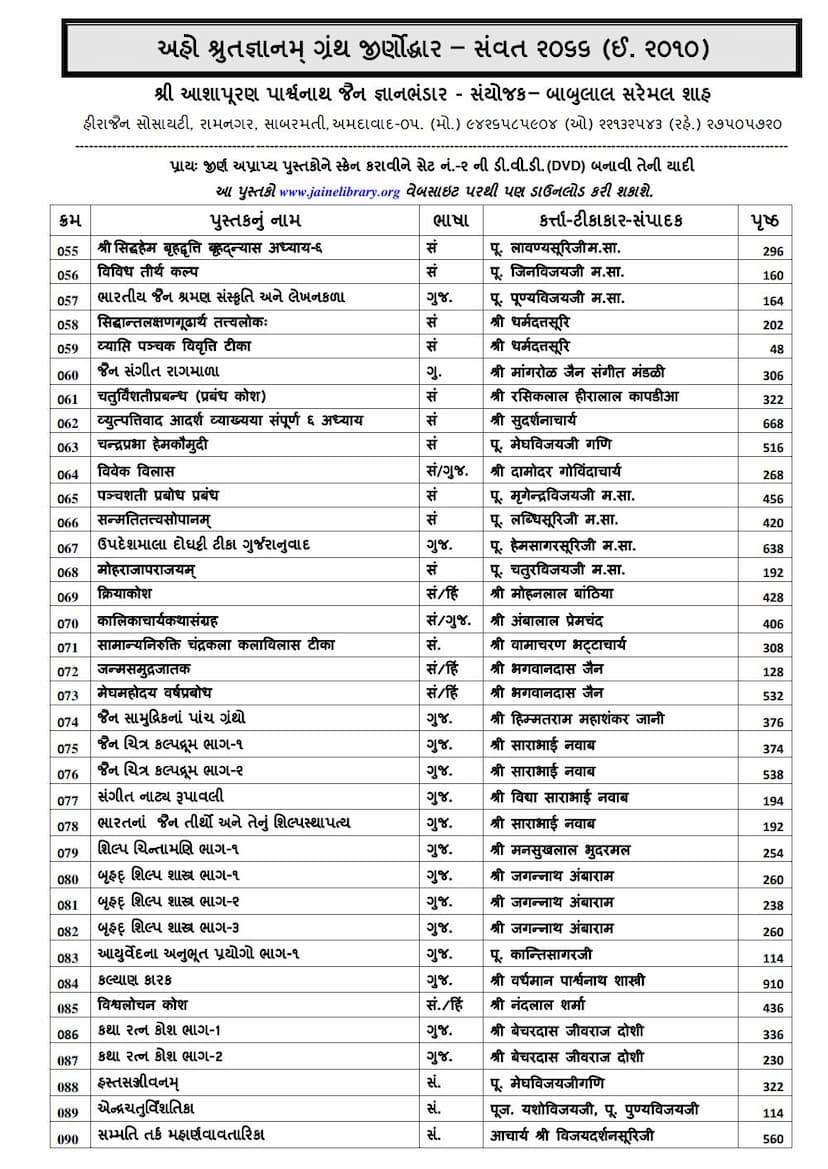Vividh Tirth Kalpa
Added to library: September 2, 2025

Summary
This document is the Table of Contents and introductory sections for the "Vividh Tirtha Kalpa," a significant Jain text compiled by Jinaprabhasuri. The provided pages focus on the initial setup and organization of this monumental work.
Here's a breakdown of the key information presented:
Book Details:
- Title: Vividh Tirtha Kalpa (विविध तीर्थ कल्प)
- Author: Jinaprabhasuri (श्रीजिनप्रभसूरिविरचित)
- Publisher: Singhi Jain Gyanpith (सिंघी जैन ज्ञानपीठ)
- Series: Singhi Jaina Series (सिंघी जैन ग्रन्थमाला)
- Number: 10
- Publication Year: V.E. 1990 / 1934 A.D. (First Part)
- Catalog Link: https://jainqq.org/explore/009519/1
Content Overview:
The initial pages detail the organizational aspects of the publication:
-
"Aho Shruta Jnanam" Grantha Jirnoddhar: This section indicates that the publication is part of a project to restore and republish old and rare Jain texts. The specific project mentioned is related to "Set No.-2" and making DVDs of scanned books.
-
List of Books: Page 1 provides a list of various Jain texts that have been digitized or published. "Vividh Tirtha Kalpa" is listed as item number 056. This list showcases the breadth of Jain literature being preserved.
-
Sponsor Information: Page 3 mentions the inspiration and financial support for the project, highlighting the role of Sadhvi Shri Jayvantashriji Maharaj and the Aamod Jain Shvetambar Murtiupujak Sangh, Aamod. Shah Babulal Saramel Bedawala is listed as the coordinator.
-
Singhi Jain Granthamala: Pages 6 and 8 explain the purpose of the Singhi Jain Granthamala series, which is to publish important Jain canonical, philosophical, historical, literary, and narrative works in various Prakrit, Sanskrit, Apabhramsa, and vernacular languages. It was founded by Shriman Bahadur Singhji Singhi in memory of his father, Shri Dalchandji Singhi. Jina Vijaya is identified as the General Editor and Adhishthata of Singhi Jaina Jnanapeetha, Shantiniketan.
-
Content of Vividha Tirtha Kalpa: Pages 7 and 9 detail the critical edition of "Vividha Tirtha Kalpa" by Jinaprabha Suri. It states that the publication includes:
- The original Sanskrit and Prakrit text with variations.
- A simple and meaningful Hindi translation.
- Extensive notes on historical and geographical matters.
- An elaborate introduction.
- Part I specifically contains the text with variants and an alphabetical index of proper names.
-
Author (Granthakar) Acarya: Section 62 introduces Jinaprabha Suri as a highly learned and influential Jain Acharya of the 14th century, who received royal recognition from Sultan Muhammad Shah of Delhi, similar to Hiravijaya Suri's influence during Akbar's reign in the 17th century. His passion for history and travel across India is highlighted, mentioning his journeys through Gujarat, Rajasthan, Malwa, Madhya Pradesh, Deccan, Karnataka, Telangana, Bihar, Kosal, Awadh, Uttar Pradesh, and Punjab. He compiled "kalpas" (chapters) for each place he visited, documenting literary and traditional information. The text exists in both Sanskrit and Prakrit, and in both prose and verse, reflecting its compilation over time.
-
Chronology of Composition: Section 63 discusses the composition period of the "kalpas." The oldest date mentioned is V.S. 1364 (Vaisarigiri Kalpa), and the author's colophon indicates completion around V.S. 1389. The compilation process spanned over 30 years, with various "kalpas" and appendices added at different times.
-
Subject Division: Section 64 outlines that the work comprises 60-61 "kalpas" or chapters, covering praise and eulogy (11-12), biographies or narratives (6-7), and the majority being descriptions of places (40-41). It mentions specific "kalpas" like the "Chaturashiti Mahatirtha Nama Sangraha Kalpa" which lists many famous pilgrimage sites by name, and others focusing on specific deities like Parshvanatha.
-
Provincial Division of Places: Section 65 attempts to categorize the described locations by province: Gujarat and Kathiawad, Rajputana and Malwa, Avadh and Bihar, United Provinces and Punjab, and South and Berar.
-
Manuscript Details: Sections 67 and 68 provide detailed descriptions of the various ancient manuscripts used for the critical edition (A, B, C, D, Pa, Pb), including their provenance, number of folios, script, condition, and any colophonic information about the scribe or date of copying. The meticulous effort in collecting and comparing these manuscripts is evident.
-
Method of Collecting Variants: Section 18 clarifies the methodology for collecting textual variants, focusing on those that are grammatically sound and historically significant, rather than every scribal error.
-
Significance and Previous Scholarly Attention: Section 19 highlights the importance of the "Tirtha Kalpa" in Jain literature and its recognition by scholars like Prof. P. Peterson, Shankar Pandurang Pandit, and Dr. G. Bühler, who studied its historical and geographical contents.
-
Publication Background: Section 610 explains the history of the present publication. An earlier attempt to publish it in collaboration with Prof. D.R. Bhandarkar for the Asiatic Society of Calcutta was initiated but did not come to full fruition. The current publisher, Singhi Jaina Granthamala, decided to proceed with their own edition due to the uncertain future of the previous project.
-
Related Works: Section 611 places the "Vividh Tirtha Kalpa" within the context of other important Jain historical texts like "Prabhavak Charitra," "Prabandhachintamani," and "Prabandhakosha," emphasizing their interconnectedness and the plan to publish them together in a synchronized format.
-
List of Kalpas (Table): Page 26 presents a comparative table showing the order of "kalpas" as found in different manuscript versions (A, Pa, Pb, B, C, D). This is a crucial tool for understanding the textual variations and the editorial process.
-
Textual Content (Beginning): Pages 31 onwards begin the actual text of the "Vividh Tirtha Kalpa" itself, starting with the "Shatrunjaya Tirtha Kalpa." The structure suggests each "kalpa" is a distinct narrative or descriptive unit related to a specific pilgrimage site.
In essence, the provided pages serve as a comprehensive introduction to the "Vividh Tirtha Kalpa," outlining its historical context, author, editorial process, and the vast scope of information it contains about Jain pilgrimage sites.